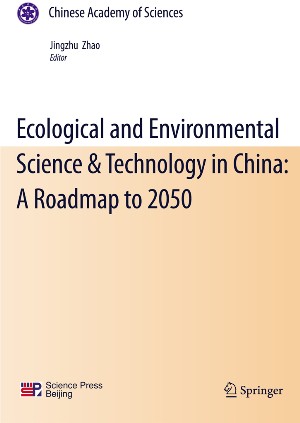Ecological and Environmental Science & Technology in China: A Roadmap to 2050
| 来源:【字号:大 中 小】
Ecological and Environmental Science & Technology in China: A Roadmap to 2050

In the future 50 years or more, with the rapid development of China’s society and economy, bottleneck restrictions and stress influence of ecological and environmental science on development of economy and society become severe day by day. Faced with such formidable challenge, we must define the overall development strategy of science and technology in ecological and environmental science, make careful analysis, advanced deployment and scientific planning of the scientific and technological development of ecological and environmental science from the perspective of forward-looking, strategic and global, so as to enable the ecological environment and scientific technology to adapt to population growth, urbanization, economic development, energy and resource consumption and the global change, thereby providing greater space for China’s future economic and social development.
Currently, many countries and international organizations have carried out researches into roadmaps of the scientific and technological development in some fields related to ecological and environmental science, such as, EU’s Report of the Environmental Technologies Action Plan, New Zealand Environmental Science Research Roadmap, WWF’s a Roadmap for a Living Planet, America’s long-term ecology research network and strategy of national ecology observation system, such roadmaps and research strategies can serve as reference for the strategic research of the roadmap.
By 2020, China’s population will be controlled within 1.45 billion, with the urbanization rate of 55%; by 2030, China’s population will exceed 1.45 billion, with the urbanization rate of 65%; by 2050, China’ s population will reach 1.5 billion, with the urbanization rate of over 70%.We could predict that with the growing of population, sustained rapid development of urbanization, rapid economic growth and the changing of industrial structure and consumption patterns, China will be faced with more severe environmental challenges, with problems of ecological and environmental science becoming more evident. However, in the world, among such major problems as the climatic change, species extinction and more people to be fed, many problems haven't still been resoled, moreover, such problems will put mankind's survival in danger.
The scientific and technological development of global ecological and environmental science demonstrate the following trends: ① retardation and adaptation to the global climatic change have become the focus of the scientific research of the earth system; ② the relationship between the ecological system and human well-being has become the major target of the international ecological research; ③ the research of integration of human activities, natural system and economic system has become the principal thinking of research for resolving the global ecological problems; ④ qualitative assessment and scientific prediction of the changing of ecological and environmental science have become the scientific and technological target in the ecological research; ⑤ ecosystem networking observation, simulation tests and virtual numerical simulation have become major means for comprehensive ecological problems; ⑥ environmental technology and green technology based on circulation of materials have become the a fundamental way to resolve environmental problems; ⑦ combination of the ecological system and human health has become the basic outlet for resolving regional environmental problems. In the future 50 years, technological demands driven by the development of society, science and technology include:
① to provide science and technology support for the ecological civilization and eco-engineering construction; ② to provide science services for management and optimized distribution of natural resources and for sustained regional development; ③ to the scientific and technological requirements for coping with the global climatic change and the global economic globalization; ④ to provide science and technology support for fulfilling international conventions and international cooperation; ⑤ to accumulate the scientific data of the long-term spatialization to promote the scientific development of the earth system; ⑥ to safeguard the environmental safety; ⑦ to maintain the health of ecosystem.
Based on the existing scientific and technological development planning, and according to technological demands driven by the development of economy, society, science and technology, we proposed eight key research fields of ecological and environmental science:
① global climatic changing and its ecological process; ② restoration of the degraded ecological system/nurturing of biodiversity; ③ urbanization and environmental quality; ④ the biological geochemistry process of lands/river basins/coastal zones; ⑤ control and restoration of the environmental pollution; ⑥ clean production and recycling economy; ⑦ environmental pollution and health effect; ⑧ advanced monitoring and forecasting techniques. Common technical approaches of the eight major key areas include: ① multidisciplinary comprehensive development of innovative and high technologies; ② building of ecological and environmental science observation platform and system theory; ③ realization of data integration and system simulation.
Goals for strategic implementation of the roadmap for the scientific and technological development of China’s ecological and environmental science are as follows:
Around 2020, the trend of degradation of China’s ecological and environmental science will be basically checked; around 2030, recovery of the typical degenerated ecological system and restoration of polluted environment; around 2050, the beautiful environment and healthy ecology will be realized.
The roadmap strategy for scientific and technological development of China’s ecological and environmental science will be implemented by establishing the security system in the following six aspects: ① to create the large research plan aimed for the methodology research; ② to set up the basic research platform for the problem-oriented interdisciplinary ecological and environmental science; ③ to build 2–3 optimized multiple-target comprehensive experiment and demonstration areas (cities); ④ to set up the pilot center integrating of state integrated ecological environment monitoring, data integration and system simulation; ⑤ to join with the neighboring countries to establish the Asian center for the global change.
